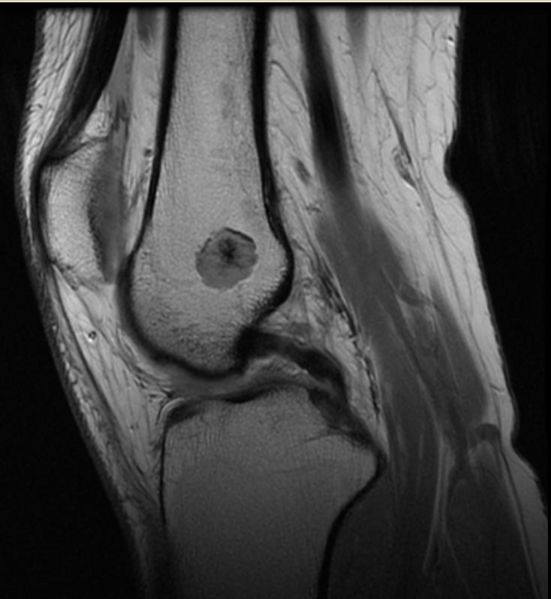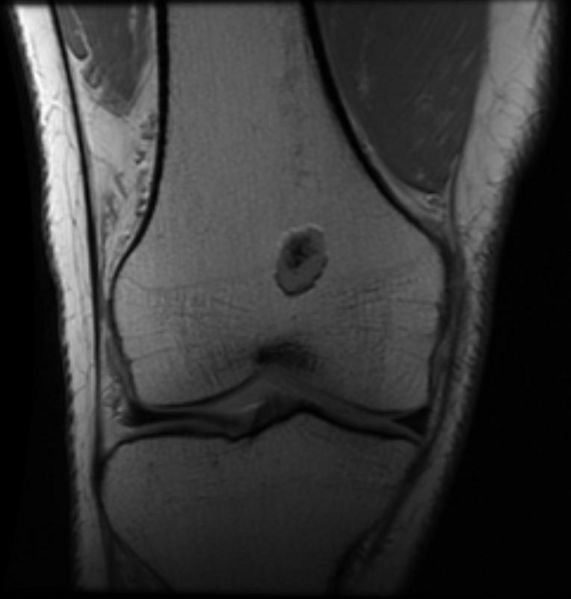Enchondroma: Difference between revisions
(→MRI) |
|||
| Line 56: | Line 56: | ||
<gallery> | <gallery> | ||
Image:Enchondroma_301.jpg | Image:Enchondroma_301.jpg|Enchondroma | ||
Image:Enchondroma_302.jpg | Image:Enchondroma_302.jpg|Enchondroma | ||
Image:Enchondroma_303.jpg | Image:Enchondroma_303.jpg|Enchondroma | ||
Image:Enchondroma_304.jpg | Image:Enchondroma_304.jpg|Enchondroma | ||
</gallery> | </gallery> | ||
Revision as of 05:38, 19 January 2009
| Enchondroma | |
| ICD-O: | 9220/0 |
|---|---|
| DiseasesDB | 33380 |
| MeSH | D002812 |
|
WikiDoc Resources for Enchondroma |
|
Articles |
|---|
|
Most recent articles on Enchondroma Most cited articles on Enchondroma |
|
Media |
|
Powerpoint slides on Enchondroma |
|
Evidence Based Medicine |
|
Clinical Trials |
|
Ongoing Trials on Enchondroma at Clinical Trials.gov Clinical Trials on Enchondroma at Google
|
|
Guidelines / Policies / Govt |
|
US National Guidelines Clearinghouse on Enchondroma
|
|
Books |
|
News |
|
Commentary |
|
Definitions |
|
Patient Resources / Community |
|
Patient resources on Enchondroma Discussion groups on Enchondroma Patient Handouts on Enchondroma Directions to Hospitals Treating Enchondroma Risk calculators and risk factors for Enchondroma
|
|
Healthcare Provider Resources |
|
Causes & Risk Factors for Enchondroma |
|
Continuing Medical Education (CME) |
|
International |
|
|
|
Business |
|
Experimental / Informatics |
Editor-In-Chief: C. Michael Gibson, M.S., M.D. [1]
Please Take Over This Page and Apply to be Editor-In-Chief for this topic: There can be one or more than one Editor-In-Chief. You may also apply to be an Associate Editor-In-Chief of one of the subtopics below. Please mail us [2] to indicate your interest in serving either as an Editor-In-Chief of the entire topic or as an Associate Editor-In-Chief for a subtopic. Please be sure to attach your CV and or biographical sketch.
Overview
An Enchondroma is a cartilage cyst found in the bone marrow. Typically, enchondroma is discovered on a X-ray scan. Enchondromas have a characteristic appearance on Magnetic Resonance Imaging (MRI) as well. They have also been reported to cause increased uptake on PET examination.
What is enchondroma?
Enchondroma is a type of benign bone tumor that originates from cartilage. Enchondroma is most common in the hand, but may also affect the femur,humerus, and the tibia. The exact aetiology of it is not known. An enchondroma most often affects the cartilage that lines the inside of the bones. The bones most often involved with this benign tumor are the miniature long bones of the hands and feet. It may, however, also involve other bones such as the femur, humerus, or tibia. Enchondromas are the most common type of hand tumor. While it may affect an individual at any age, it is most common between the ages of 10 and 20 years. The occurrence between males and females is equal.
Cause
While the exact cause of enchondroma is not known, it is believed to occur either as an overgrowth of the cartilage that lines the ends of the bones, or as a persistent growth of original, embryonic cartilage.
Associated conditions
An enchondroma may occur as an individual tumor or several tumors. The conditions that involve multiple lesions include the following:
Ollier's disease (enchondromatosis) - when multiple sites in the body develop the tumors.
Maffucci's syndrome - a combination of multiple tumors and angiomas (benign tumors made up of blood vessels).
Symptoms
Individuals with an enchondroma often have no symptoms at all. The following are the most common symptoms of an enchondroma. However, each individual may experience symptoms differently. Symptoms may include:
- Hand pain that may occur if the tumor is very large, or if the affected bone has weakened causing a hand fracture
- Enlargement of the affected finger
- Slow bone growth in the affected area
The symptoms of enchondroma may resemble other medical conditions or problems. Always consult your physician for a diagnosis.
Diagnosis
Because an individual with an enchondroma has few symptoms, diagnosis is sometimes made during a routine physical examination, or if the presence of the tumor leads to a fracture.In addition to a complete medical history and physical examination, diagnostic procedures for enchondroma may include the following:
- x-ray - a diagnostic test which uses ionizing radiation to produce images of internal tissues, bones, and organs.
- radionuclide bone scan - a nuclear imaging method to evaluate any degenerative and/or arthritic changes in the joints; to detect bone diseases and tumors; to determine the cause of bone pain or inflammation. This test is to rule out any infection or fractures.
- magnetic resonance imaging (MRI)[1] - a diagnostic procedure that uses a combination of large magnets, radiofrequencies, and a computer to produce detailed images of organs and structures within the body. This test is done to rule out any associated abnormalities of the spinal cord and nerves.
- computed tomography scan (Also called a CT or CAT scan.) - a diagnostic imaging procedure that uses a combination of x-rays and computer technology to produce cross-sectional images (often called slices), both horizontally and vertically, of the body. A CT scan shows detailed images of any part of the body, including the bones, muscles, fat, and organs. CT scans are more detailed than general x-rays.
MRI
-
Enchondroma
-
Enchondroma
-
Enchondroma
-
Enchondroma
Treatment
Specific treatment for enchondroma is determined by a physician based on the age, overall health, and medical history of the patient. Other considerations include:
- extent of the disease
- tolerance for specific medications, procedures, or therapies
- expectations for the course of the disease
- opinion or preference of the patient
Treatment may include:
- surgery (in some cases, when bone weakening is present or fractures occur)
- bone grafting - a surgical procedure in which healthy bone is transplanted from another part of the patient's body into the affected area.
If there is no sign of bone weakening or growth of the tumor, observation only may be suggested. However, follow-up with repeat x-rays may be necessary. Some types of enchondromas can develop into malignant, or cancerous, bone tumors later. Careful follow-up with a physician may be recommended.



